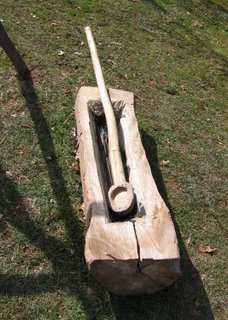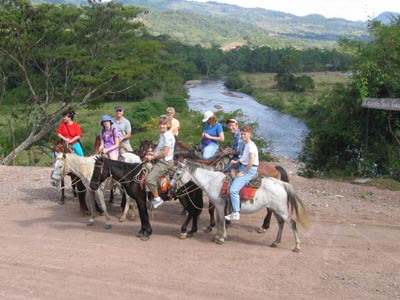
In the above picture, a volunteer is explaining how Native Americans made maple syrup in American colonial times. The maple sap was collected in hewed-out sections of logs. To make the maple sap turn into maple syrup and eventually maple sugar, hot stones heated in a wood fire were put into the maple sap. By this method, they evaporated the water from the maple sap.

The above bowl contains the three essential non-meat foods of the Native Americans. They were corn, squash, and beans. They would often mix maple sugar together with these three foods for trail rations on hunting or migratory trips. Perhaps this was their equivalent of our power bars of today.

Colonial Americans first learned about maple syrup from Native Americans. The colonists initially used hewed out logs and wooden stirrers such as in the picture above. They then followed the same method as Native Americans of making maple syrup by putting hot stones in the sap.

However, colonial Americans with their technology quickly switched over to making maple syrup in huge cast iron kettles heated directly by wood fires underneath them.
It was fascinating to watch, learn, and sample even though it was a blustery cold day.




12 comments:
interesting!. did you get to taste it?
Hi chezhiyan. Yept, I tasted some maple sugar crystals. Mighty sweet. I almost bought a small jar of maple cream; but that would have cost me $10.00.
Wow how interesting,I never knew thats how maple syrup is made. Now I can explain it to my kid who likes to have it from time to time.
Tim, I always learn something interesting from your site. We don't have enough maple trees to do any large amount of sugaring around here, but the naturalists at the forest preserve district does demonstrations.
Real maple syrup, not the fake stuff sold in stores, is very potent and sweet....a little goes a very long way. $10 seems like a lot of money but the maple cream would probably last a long time. It is quite an extravagance though.
This post reminds me that I have one in my head somewhere from when we went to a Maple Sugar farm in Quebec City back in 2000. I may make the post this next week while in Germany and make a link to yours, if you don't mind!
Hi consise10. I'm glad you found it informative and useful.
Hi zanne. Glad you enjoy my site. And I'm sure you're right that a little bit would go a long way.
Hi ginnie. If you get that post written, feel perfectly free to link your post to my post.
Thanks for taking us along with you. Looks like fun!
Thanks, fred. It was fun to watch and taste. I also learned some things I did not know before.
Ahh, maple syrup is very popular around our house. :-) Many years ago I took a tin of real maple syrup to Greece with me as a gift, and no one would believe that it had come from a tree. They thought I was joking when I explained how it was made.
Wow, this kind of thing is so interesting. I am such a history buff. I am also a maple syrup buff... mmmmm
Hi san nakji. I find history fascinating, too. I especially like to learn about how ordinary people lived throughout the different periods of history. Political history is interesting, too; but it is often a step or more removed.
Just to let you know that I have directed people to this post in my Maple Syrup post today :)
Post a Comment